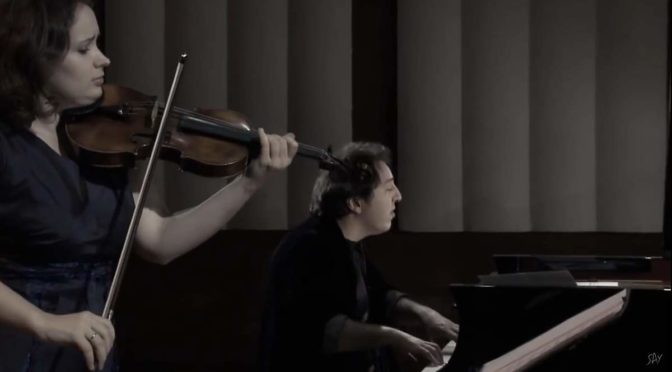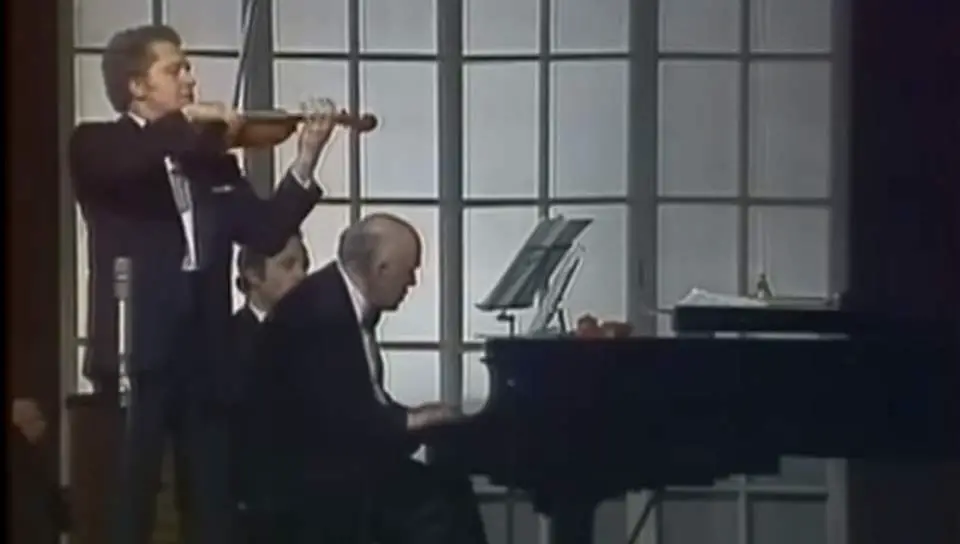Moldovan-Austrian violinist Patricia Kopatchinskaja and the Turkish pianist Fazıl Say perform Franz Schubert’s Violin Sonata in A minor, D 385. The sonata was composed in 1816 when the Austrian composer was 19 years old.
Franz Schubert’s Violin Sonata in A minor, D 385
The violin was Schubert’s first seriously studied instrument: at age six, Franz began to receive regular instruction from his father, and a year later was enrolled at his father’s school. His formal musical education started around the same time. His father taught him basic violin technique, and his brother Ignaz gave him piano lessons.
In 1816, he wrote three Sonatas for violin and piano (D 384, D 385, and D 408). These were his first pieces for violin and piano, composed when he was nineteen.
Violin Sonata in A minor, D 385, composed in 1816, exemplifies Schubert’s early mastery in blending structural form with melodic richness.
The work was published as sonatinas posthumously but called a sonata by the composer.
The piece reflects Schubert’s affinity for lyrical melodies and intricate harmonies, a characteristic that distinguishes much of his work. The A minor key provides a backdrop that allows for expressive depth and contrasts, which Schubert explores through the interplay between the violin and the piano. This sonata, like many of his compositions from this period, showcases his ability to develop themes that are at once heartfelt and complex, weaving together a tapestry of musical ideas that are both introspective and dynamic.
Schubert’s compositional style in this sonata also shows influences from the classical traditions of Mozart and Beethoven, yet he infuses his work with a distinctive voice that hints at the Romantic era’s burgeoning expressiveness. His music, particularly in works like this sonata, often portrays an emotional landscape, where the lyrical themes serve not only as musical expressions but also as conveyors of nuanced emotional states.
The sonata is structured in a way that allows for a dialogue between the violin and the piano, with the piano more than just an accompaniment but a full partner in the musical exploration. This partnership creates a rich harmonic foundation upon which the violin melody can soar and evolve. Schubert’s use of modulations and thematic development in the sonata lends it a dramatic quality that keeps the listener engaged throughout the piece.
Movements
The Violin Sonata in A minor, D 385 is in four movements:
- Allegro moderato
- Andante
- Menuetto. Allegro
- Allegro
1. Allegro moderato
The first movement of Franz Schubert’s Violin Sonata in A minor, D 385, is marked “Allegro moderato” and sets the tone for the entire sonata with its emotional depth and intricate interplay between the violin and piano. This movement is characterized by its lyrical themes and the subtle tension it builds through dynamic contrasts and harmonic explorations.
In typical Schubert fashion, the Allegro moderato opens with a compelling melodic line that immediately captures the listener’s attention. The melody, initially introduced by the violin, is somber and reflective, embodying the moody characteristics of the A minor key. The piano complements this with a supportive harmonic structure that enhances the melody’s expressiveness without overpowering it.
Schubert skillfully develops the thematic material, using variations in dynamics and articulation to explore different emotional nuances. The interaction between the violin and piano is particularly notable; they engage in a musical dialogue that feels both intimate and expansive. The piano’s role is not merely accompanimental but integral to the thematic development and the overall texture of the movement.
The development section of the movement is rich with modulations, taking the listener through a series of harmonic shifts that maintain a sense of anticipation and engagement. Schubert uses these modulations to explore new tonal landscapes, while still recalling the main themes, thus providing continuity and depth to the movement.
2. Andante
The second movement of Franz Schubert’s Violin Sonata in A minor, D 385, is marked “Andante” and provides a contrast to the energetic and emotionally charged first movement. This section of the sonata exhibits a more serene and contemplative character, highlighting Schubert’s ability to craft beautiful, lyrical melodies that evoke a deep sense of introspection and calm.
In this Andante, the melody is carried predominantly by the violin, which sings a tender and somewhat melancholic tune over a subdued and steady accompaniment from the piano. The movement has a flowing, song-like quality that is typical of Schubert’s lyrical style. The melody is simple yet profound, with a clear, singing line that speaks directly to the listener’s emotions.
The structure of the Andante is straightforward, with a clear thematic development that allows the violin to explore various expressive nuances of the main melody. Schubert enhances the emotional depth of the movement through subtle shifts in harmony and dynamics, which gently push and pull the listener through a landscape of sound that is both soothing and moving.
The interaction between the violin and piano in this movement is less about dialogue and more about partnership, with the piano providing a harmonic foundation that supports the violin’s explorations. The piano part, while less prominent than in the first movement, is essential in creating the harmonic color and texture that define the mood of the Andante.
3. Menuetto. Allegro
The third movement of Franz Schubert’s Violin Sonata in A minor, D 385, is marked “Menuetto: Allegro” and serves as a lively and rhythmic contrast to the introspective Andante that precedes it. This movement embodies the traditional Minuet form but is infused with Schubert’s characteristic vigor and emotional depth.
This Menuetto is energetic and robust, featuring a rhythmic drive that provides a spirited change of pace within the sonata. The opening theme is bold and clearly articulated, delivered by the violin with strong support from the piano. The movement’s structure follows the typical minuet and trio format, where the main section of the dance-like minuet is followed by a contrasting trio section before a return to the initial minuet theme.
In the minuet section, Schubert uses a straightforward, rhythmic melody that is both catchy and dynamic. The interaction between the violin and piano is playful and tightly synchronized, with both instruments sharing the spotlight in propelling the movement forward. The staccato notes and rhythmic accents enhance the dance-like quality of the music, making it feel both formal and lively.
The trio section provides a contrast, often smoother and softer, with a lyrical and more subdued melody. Here, Schubert explores different textures and a more gentle expression, offering a brief respite from the vigorous minuet. The piano and violin weave together in a more harmonious and less percussive manner, highlighting Schubert’s skill in varying musical textures and moods within a single piece.
After the trio, the return to the initial minuet theme brings back the movement’s energetic spirit, concluding the Menuetto with a sense of completion and rhythmic vitality. This third movement showcases Schubert’s ability to blend traditional dance forms with his unique lyrical and harmonic language, creating a piece that is both entertaining and structurally sophisticated.
4. Allegro
The fourth movement of Franz Schubert’s Violin Sonata in A minor, D 385, is marked “Allegro” and serves as a vigorous and compelling conclusion to the sonata. This finale is characterized by its brisk tempo and the energetic interplay between the violin and the piano, encapsulating the dynamic and expressive range that Schubert masterfully demonstrates throughout the piece.
This Allegro movement is driven by a lively, rhythmic theme that showcases the technical prowess of the performers. The violin part is particularly challenging, with rapid passages and shifts that demand both agility and expressive intensity. The piano complements this with equally energetic and intricate accompaniment, providing a robust harmonic foundation that enhances the overall momentum of the movement.
Schubert structures this finale with a sense of urgency and forward motion that keeps the listener engaged. The thematic material is developed through a series of variations that explore different harmonic and rhythmic possibilities, adding layers of complexity to the initial theme. This development not only demonstrates Schubert’s compositional skill but also creates a rich tapestry of sound that is both exhilarating and satisfying.
The interplay between the violin and piano is particularly notable in this movement. Both instruments engage in a spirited dialogue, with themes tossed back and forth, sometimes in imitation, other times in harmonic support. This interaction creates a dynamic and exciting atmosphere, making the Allegro a thrilling end to the sonata.
Sources
- Franz Schubert on Wikipedia
- Violin Sonatas, Op. 137 (Schubert) on Wikipedia
- Violin Sonata in A minor, D. 385 (Schubert, Franz) on the International Music Score Library Project website
- Brahms: Violin Sonata No. 1 [Yuja Wang, Leonidas Kavakos] - May 3, 2024
- Chopin: Prelude No. 15 “Raindrop” [YUNDI] - May 1, 2024
- Beethoven: Piano Concerto No. 3 [Olga Scheps] - April 30, 2024

